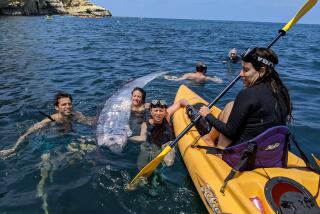Aquarium’s Fishing for a Great White Shark
With a small armada of ships and a huge undersea pen, the Monterey Bay Aquarium has launched a three-year effort to be the first to capture and successfully exhibit a great white shark, the ocean’s most feared predator.
Scientists from the aquarium spent last month trolling up and down the coast from Santa Barbara to San Diego, trying to hook a baby great white. A tugboat, one of four vessels involved in the Ventura-based operation, towed a 5-million-gallon undersea pen to the Channel Islands to hold the animal if captured.
According to biologists, great white sharks have never survived more than three weeks in captivity, largely because they won’t eat. Researchers hope to reverse the trend by reducing the stress of capture, using a suitable tank and focusing on sharks younger than 1 year.
The white shark pups, 3 feet long at birth, are known to inhabit the shallow waters just a mile or two off the coast of Ventura, where they sometimes get tangled in commercial fishing nets.
A fishing boat chartered by the aquarium spent 28 days trolling for the young sharks, deploying 8,000 mackerel-baited hooks in the process. But unusually cold and murky water kept the animals away.
Officials plan to return next year during the animals’ birthing season to try again.
“If it was easy, our researchers could have done it years ago,” said John O’Sullivan, curator of field operations for the aquarium, which is devoting $1.1 million for the attempts.
“There are no experts who can tell you what is going on with these sharks,” said O’Sullivan, who rented a house near Ventura Harbor during this year’s effort. “You can fill a thimble with the information we know about them.”
Tim Athens, skipper of the Oxnard-based boat that fished for the great whites, had planned to limit his search to Ventura County, but cold water forced him to travel as far south as Encinitas.
“We started a little early because that’s when the pen was available,” he said. “There is not a lot known about juvenile white sharks, but they congregate in the Ventura flats.”
Some scientists think white sharks are born in warm water and move north when they get older and their diet changes from fish to mammals.
Kip Whited, a commercial halibut fisherman in Ventura, said baby sharks get ensnared in his nets every year. “We would catch them from the surf line to eight miles out,” he said. “We usually just let them go.”
Exhibiting a great white shark would be both a commercial and scientific coup. Researchers could examine the shark’s mysterious habits up close, while the public could get eyeball to eyeball with an animal that can reach 21 feet in length, weigh 7,000 pounds and have up to 3,000 teeth, each 3 inches long.
“It would be a wonderful spokesman for the aquarium,” O’Sullivan said.
Never cuddly to begin with, great whites have yet to overcome their image as brutal killers with a taste for young swimmers, a reputation largely created by the movie “Jaws.”
Scientists now believe the sharks attack people when they mistake them for sea lions. There have been 82 great white shark attacks in California waters since 1950, eight of them fatal, said John McCosker, former director of San Francisco’s Steinhart Aquarium and currently chairman of aquatic biology at the California Academy of Sciences.
In 1989, a kayaker was killed by a great white off Malibu. In 1994, a sea urchin diver died after an attack near San Miguel Island in the Channel Islands chain. Last week, a surfer was bitten at Stinson Beach north of San Francisco, where another great white mauled a boogie boarder in 1998.
If a young white is caught, it would go in the pen anchored near Santa Cruz Island, where divers would measure it, take DNA samples and--most importantly--try to get it to eat.
The aquarium could tow the pen with the shark back to Monterey Bay or move it in a 3,000-gallon, 44-foot truck dubbed the “Tunabago.”
If the shark showed any signs of distress, it would be tagged and released.
“We are not in the business of catching and killing animals just to try and put them on exhibit,” O’Sullivan said, noting that the aquarium had a white shark for 11 days in 1984, but the animal died.
If the captured shark thrived, it would go into a million-gallon, 90-foot-long, 35-foot-deep tank.
Other aquariums also briefly held great whites. In 1981, Sea World in San Diego had one for 16 days before it died, and the Steinhart Aquarium kept one for four days before releasing it.
“Our white shark lived longer than anyone else’s because we let it go before it died,” said McCosker, who has co-written a book on great whites.
That 7-foot shark was moved from Bodega Bay to the aquarium, but once inside, it banged so hard against the tank that it exhausted itself.
“If Monterey succeeds, they won’t exactly humanize these creatures, but they will make people understand that they are not the rogue killers we knew from ‘Jaws,’ ” McCosker said. “They are endangered throughout their range and are very key players in the ecosystem. They should be pitied, not feared.”
More to Read
Sign up for Essential California
The most important California stories and recommendations in your inbox every morning.
You may occasionally receive promotional content from the Los Angeles Times.










